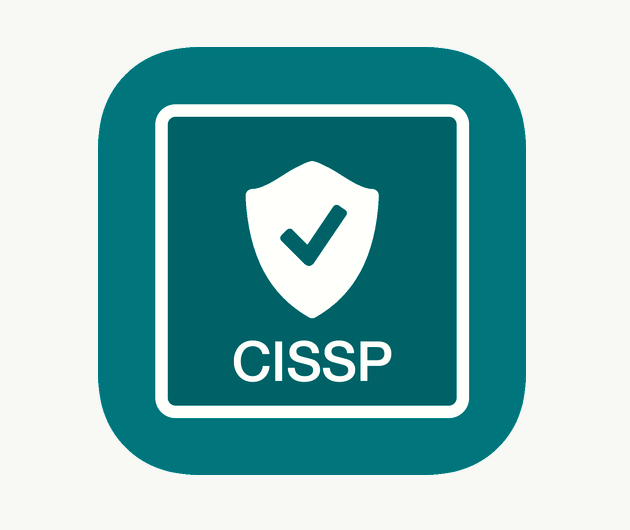CISSP - Question Bank 03
Test your knowledge of CISSP with these multiple choice questions. Each Question Bank includes 20 practice questions that have been designed to measure your knowledge of key ideas.
A key factor to keep in mind is that guessing is better than not answering a question.
Every single question on the CISSP exam is a four-option multiple choice question with a single correct answer. Some are straightforward, such as asking you to select a definition. Some are a bit more involved, such as asking you to select the appropriate concept or best practice. And some questions present you with a scenario or situation and ask you to select the best response.
StartQ1. What is layer 4 of the OSI model?
A. Presentation
B. Network
C. Data Link
D. Transport
Q2. What is encapsulation?
A. Changing the source and destination addresses of a packet
B. Adding a header and footer to data as it moves down the OSI stack
C. Verifying a person’s identity
D. Protecting evidence until it has been properly collected
Q3. Which OSI model layer manages communications in simplex, half-duplex, and full-duplex modes?
A. Application
B. Session
C. Transport
D. Physical
Q4. Which of the following is the least resistant to EMI?
A. Thinnet
B. 10Base-T UTP
C. 10Base5
D. Coaxial cable
Q5. Which of the following cables has the most twists per inch?
A. STP
B. UTP
C. 100Base-T
D. 1000Base-T
Q6. Which of the following is not true?
A. Fiber-optic cable offers very high throughput rates.
B. Fiber-optic cable is difficult to install.
C. Fiber-optic cable is expensive.
D. Communications over fiber-optic cable can be tapped easily.
Q7. Which of the following is not one of the most common LAN technologies?
A. Ethernet
B. ATM
C. Token Ring
D. FDDI
Q8. Which networking technology is based on the IEEE 802.3 standard?
A. Ethernet
B. Token Ring
C. FDDI
D. HDLC
Q9. What is a TCP wrapper?
A. An encapsulation protocol used by switches
B. An application that can serve as a basic firewall by restricting access based on user IDs or system IDs
C. A security protocol used to protect TCP/IP traffic over WAN links
D. A mechanism to tunnel TCP/IP through non-IP networks
Q10. Which of the following protocols is connectionless?
A. TCP
B. UDP
C. IP
D. FTP
Q11. By examining source and destination address, application usage, source of origin, and the relationship between current packets with the previous packets of the same session, ____________ firewalls are able to grant a broader range of access for authorized users and activities and actively watch for and block unauthorized users and activities.
A. Static packet-filtering
B. Application-level gateway
C. Stateful inspection
D. Circuit-level gateway
Q12. _________________ firewalls are known as third-generation firewalls.
A. Application-level gateway
B. Stateful inspection
C. Circuit-level gateway
D. Static packet-filtering
Q13. Which of the following is not true regarding firewalls?
A. They are able to log traffic information.
B. They are able to block viruses.
C. They are able to issue alarms based on suspected attacks.
D. They are unable to prevent internal attacks.
Q14. Which of the following is not a routing protocol?
A. OSPF
B. BGP
C. RPC
D. RIP
Q15. A ___________________ is an intelligent hub because it knows the addresses of the systems connected on each outbound port. Instead of repeating traffic on every outbound port, it repeats only traffic out of the port on which the destination is known to exist.
A. Repeater
B. Switch
C. Bridge
D. Router
Q16. ___________________ is a standards-based mechanism for providing encryption for point-topoint TCP/IP traffic.
A. UDP
B. SSL
C. IPSec
D. SDLC
Q17. Which public-private key security system was developed independently of industry standards but has wide Internet grassroots support?
A. SLIP
B. PGP
C. PPTP
D. PAP
Q18. What authentication protocol offers no encryption or protection for logon credentials?
A. PAP
B. CHAP
C. SSL
D. RADIUS
Q19. ___________________ is a layer 2 connection mechanism that uses packet-switching technology to establish virtual circuits between the communication endpoints.
A. ISDN
B. Frame Relay
C. SMDS
D. ATM
Q20. Which of the following IP addresses is not a private IP address as defined by RFC 1918?
A. 10.0.0.18
B. 169.254.1.119
C. 172.31.8.204
D. 192.168.6.43
- Question Bank 00
- Question Bank 01
- Question Bank 02
- Question Bank 03
- Question Bank 04
- Question Bank 05
- Question Bank 06
- Question Bank 07
- Question Bank 08
- Question Bank 09
- Question Bank 10
- Question Bank 11
- Question Bank 12
- Question Bank 13
- Question Bank 14
- Question Bank 15
- Question Bank 16
- Question Bank 17
- Question Bank 18
- Question Bank 19


